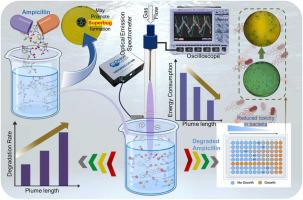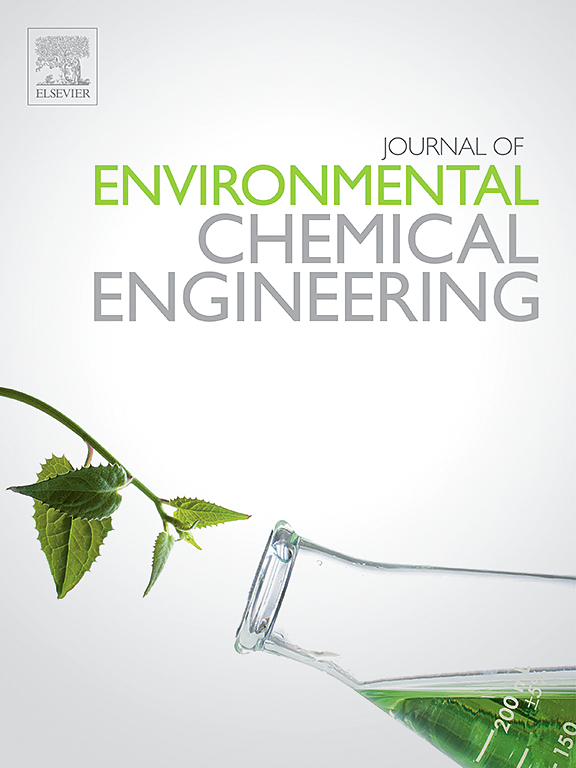Investigating the impact of plasma plume length of atmospheric pressure plasma jet on ampicillin degradation efficiency and toxicity
IF 7.4
2区 工程技术
Q1 ENGINEERING, CHEMICAL
引用次数: 0
Abstract
Emerging pharmaceutical micropollutant: ampicillin-degradation in water using atmospheric pressure plasma jets (APPJs) is examined, and its environmental impact is evaluated. To this end, comprehensive plasma characterization techniques, including electrical and optical analyses, are used, to supplement existing research that primarily focused on degradation outcomes. The results of these techniques provide deeper insights into the degradation process. Additionally, the solution properties are assessed by examining the treated liquids and quantifying the corresponding hydrogen peroxide and nitrite concentrations, clarifying the role of reactive species in the degradation process. High-performance liquid chromatography analysis provides essential insights into degradation kinetics and rate constants. A comprehensive framework is developed for understanding the degradation of ampicillin by APPJs, combining plasma diagnostics, solution characterization, chemical assays, degradation kinetics, and toxicity analysis. Our study, grounded in these multidisciplinary approaches, contributes to both the fundamental understanding of plasma-based degradation and optimization of plasma plume length. Our findings highlight the potential of plasma jet technologies in addressing pharmaceutical pollution and promoting sustainable wastewater management practices. This research can advance efforts to enhance the efficiency of pharmaceutical waste treatment, ultimately safeguarding the health and well-being of aquatic ecosystems and human populations.

研究常压等离子体射流的等离子体羽流长度对氨苄西林降解效率和毒性的影响
研究了新出现的制药微污染物:使用大气压等离子体射流(APPJs)在水中降解氨苄西林的情况,并评估了其对环境的影响。为此,使用了包括电学和光学分析在内的综合等离子体表征技术,以补充主要侧重于降解结果的现有研究。这些技术的结果有助于深入了解降解过程。此外,通过检查处理过的液体并量化相应的过氧化氢和亚硝酸盐浓度,对溶液特性进行了评估,从而明确了活性物种在降解过程中的作用。通过高效液相色谱分析,可以深入了解降解动力学和速率常数。为了解 APPJ 对氨苄西林的降解,我们建立了一个综合框架,将血浆诊断、溶液表征、化学检测、降解动力学和毒性分析结合在一起。我们的研究以这些多学科方法为基础,有助于从根本上理解基于等离子体的降解和优化等离子体羽流长度。我们的研究结果凸显了等离子体喷射技术在解决制药污染和促进可持续废水管理实践方面的潜力。这项研究可以推动提高制药废物处理效率的工作,最终保障水生生态系统和人类的健康和福祉。
本文章由计算机程序翻译,如有差异,请以英文原文为准。
求助全文
约1分钟内获得全文
求助全文
来源期刊

Journal of Environmental Chemical Engineering
Environmental Science-Pollution
CiteScore
11.40
自引率
6.50%
发文量
2017
审稿时长
27 days
期刊介绍:
The Journal of Environmental Chemical Engineering (JECE) serves as a platform for the dissemination of original and innovative research focusing on the advancement of environmentally-friendly, sustainable technologies. JECE emphasizes the transition towards a carbon-neutral circular economy and a self-sufficient bio-based economy. Topics covered include soil, water, wastewater, and air decontamination; pollution monitoring, prevention, and control; advanced analytics, sensors, impact and risk assessment methodologies in environmental chemical engineering; resource recovery (water, nutrients, materials, energy); industrial ecology; valorization of waste streams; waste management (including e-waste); climate-water-energy-food nexus; novel materials for environmental, chemical, and energy applications; sustainability and environmental safety; water digitalization, water data science, and machine learning; process integration and intensification; recent developments in green chemistry for synthesis, catalysis, and energy; and original research on contaminants of emerging concern, persistent chemicals, and priority substances, including microplastics, nanoplastics, nanomaterials, micropollutants, antimicrobial resistance genes, and emerging pathogens (viruses, bacteria, parasites) of environmental significance.
 求助内容:
求助内容: 应助结果提醒方式:
应助结果提醒方式:


